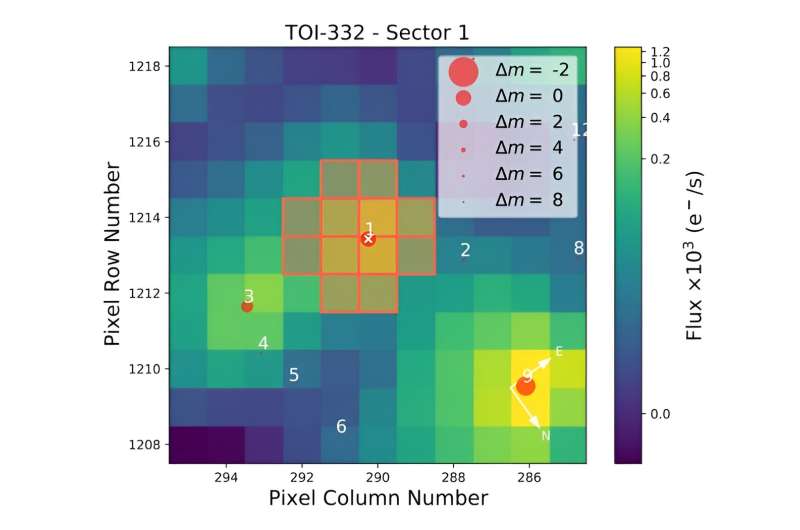August 30, 2023 report
This article has been reviewed according to Science X's editorial process and policies. Editors have highlighted the following attributes while ensuring the content's credibility:
fact-checked
preprint
trusted source
proofread
Dense Neptune-sized exoplanet discovered with TESS

Using NASA's Transiting Exoplanet Survey Satellite (TESS), an international team of astronomers has discovered a new massive and dense exoplanet. The newfound alien world, designated TOI-332 b, is one of the densest Neptune-sized planets known to date. The finding is reported in a paper published August 23 on the pre-print server arXiv.
TESS is conducting a survey of about 200,000 of the brightest stars near the sun with the aim of searching for transiting exoplanets. So far, it has identified nearly 6,800 candidate exoplanets (TESS Objects of Interest, or TOI), of which 379 have been confirmed so far.
A group of astronomers led by Ares Osborn of the University of Warwick, UK, has now confirmed another TOI monitored by TESS. They identified a transit signal in the light curve of a K-dwarf star designated TOI-332 (also known as TIC 139285832). Planetary nature of this signal was verified by follow-up observations using ground-based facilities.
"The TOI-332 system (TIC 139285832) was observed in TESS Sectors 1 (July 25—Aug 22, 2018, hereafter S1) and 2 (August 22—September 20, 2018, hereafter S2) with a 30 min cadence in the full-frame images (FFIs)," the researchers wrote in the paper.
TOI-332 b has a radius of about 3.2 Earth radii and an unusually large mass of 57.2 Earth masses, what yields a very high density—at a level of 9.6 g/cm3. The newfound planet orbits its host every 18.65 hours, at a distance of 0.016 AU from it. The equilibrium temperature of TOI-332 b was calculated to be around 1,871 K.
Based on the results, the astronomers classified TOI-332 b as an ultra-short period (USP) Neptune-sized exoplanet. They added that it represents the so-called "Neptunian desert"—a region of period-radius and period-mass parameter space where planets have, so far, been rarely found. This desert encompasses planets between 2 and 9 Earth radii, with masses ranging from 10 to even 250 Earth masses, and orbital periods shorter than five days.
The researchers noted that the interior structure of TOI-332 b is most likely dominated by refractory materials, potentially more similar to that of terrestrial planets. They found that it likely possesses a negligible hydrogen-helium envelope, what presents a challenge to planetary formation theories.
"This unusual planet tests what we currently understand about planet formation; how such a giant core exists without a gaseous envelope remains an unanswered question," the authors of the paper wrote.
When it comes to the parent star TOI-332, it has a spectral type K0V and is estimated to be five billion years old. The star, located some 726.5 light years away from the Earth, is about 12% smaller and less massive than the sun. The effective temperature of TOI-332 was found to be 5,251 K.
More information: Ares Osborn et al, TOI-332 b: a super dense Neptune found deep within the Neptunian desert, arXiv (2023). DOI: 10.48550/arxiv.2308.12137
Journal information: arXiv
© 2023 Science X Network





















